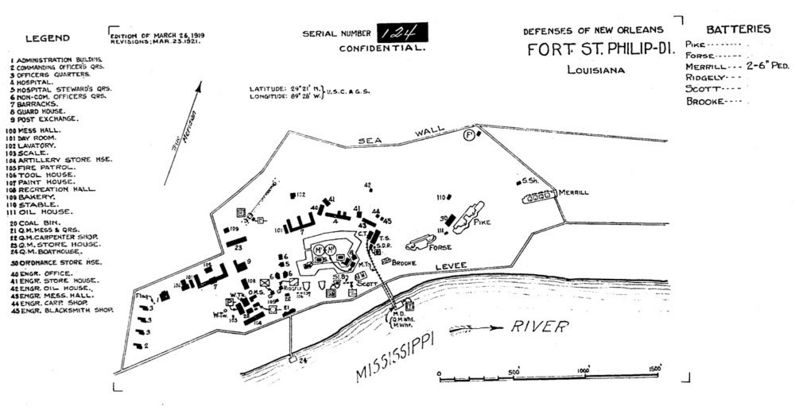Fort St. Philip
| More information at Warlike, Wikidata, Wikipedia
Fort St. Philip (1792-1922) - A Coastal Fort first established in 1792 by the Spanish as Fort San Felipe and taken over in 1808 by American Troops as a part of the Louisiana Purchase Territory (1803-1804) and renamed Fort St. Philip. Located on the Mississippi River at Plaguemines Bend, Plaquemines Parish, Louisiana. Abandoned in 1922.
Spanish PeriodThe Spanish Governor of Louisiana began construction of Fort San Felipe at the strategic Plaquemines Bend in the Mississippi River in 1792 and completed it in 1795. Louisiana TerritoryThe Louisiana Purchase became effective in 1804 giving the United States control over a vast territory that included all of Louisiana. American forces occupied the Spanish fort and, in February 1808, began to improve the post. Over two million bricks were ordered for the construction around the old fortification. The construction was essentially completed by 30 Jun 1810. War of 1812 (1812-1814)The fort was involved in the British invasion of New Orleans during the War of 1812 and was bombarded by five British ships for nine days in January 1815. The fort withstood the bombardment and the British ships did not pass. Over 1000 shells were fired at the fort but the 366 man garrison suffered only two dead and seven wounded. Construction of Fort Jackson (2) across the river was begun in 1814 to strengthen the defense of the river. U.S. Civil War (1861-1865)Part of the Harbor Defense of the Mississippi. On 8 Jan 1861, just before the start of the U.S. Civil War, Fort Jackson and Fort St. Philip were seized from their Federal garrisons by Louisiana forces. Louisiana troops occupied both Fort St. Philip and Fort Jackson until an epic battle with Union Admiral David Farragut's fleet of gunboats in April 1862 at Plaquemines Bend. Farragut's mission was to seize control of the Mississippi and split the Confederacy in two. In April 1862 Farragut's fleet engaged both forts and attempted to destroy them with a six-day bombardment. The bombardment failed to destroy the forts and Farragut was forced to make a run past both forts with 17 wooden ships at 2 AM on 24 Apr 1862. In the ensuing Battle of Forts Jackson and St. Philip, 13 of the ships made it past the forts, and Farragut went on to New Orleans which surrendered to him on 29 Apr 1862. Both forts gave a good account of themselves and in the end it was probably the lack of enough cannon that enabled the fleet to get by. Fort Jackson was designed for 93 gun emplacements but had only 69 guns emplaced while Fort St. Philip had only 45 guns. The Union gunboats were able to send a total of 8,100 rounds against both forts. Both forts were surrendered to Union forces on 28 Apr 1862 and then garrisoned by them until the end of the war. Endicott Period (1890-1910)Construction began in 1895 on the first of six Endicott Period gun batteries and continued until the last one was complete in 1907. All of the new batteries were constructed outside of the old fort but within an area between a river levee and a seawall. During the same time period, two additional gun batteries were being built across the river at Fort Jackson (2). Endicott Period post construction at Fort St. Philip started in 1900 with a minimum number of essential buildings, NCO quarters and a single 60 man barracks. Considering that Fort Jackson (2) was a sub-post of Fort St. Philip and had no quarters of its own, this represented support for only a detachment. In 1908, additional construction expanded the post to a company and a half size by adding a 120 man barracks, four sets of officers quarters, a post exchange/gymnasium and other support buildings. In 1913 Battery Ridgely became the first Endicott Period battery on Fort St. Philip to be deactivated. Both of the guns and carriages were removed and shipped to Fort Ruger in Honolulu, Hawaii, 24 Jul 1913. Battery Ridgely's magazines were later converted into a Post Telephone and Fire Control switchboard.

World War I (1917-1918)World War I saw the deactivation of two more Endicott Period gun batteries and the reduction of a third. Disappearing gun Battery Pike and Battery Forse were deactivated during the war and two of the four 6" guns of Battery Merrill were removed. By the end of the war, only two 6" guns and four 3" guns remained at the fort. Use of Fort St. Philip and Fort Jackson (2) for coast defense purposes was discontinued 11 Mar 1920 as a part of the postwar disarmament program. The remaining gun batteries were disarmed and the guns shipped out over the next year and by 1922 both posts were abandoned. In 1960 Fort Jackson (2) and Fort St. Philip were designated National Historic Landmarks.
Current StatusPrivate property, access by boat with permission, in very dangerous condition. No period guns or carriages in place.
See Also: Sources:
Links:
Visited: No | |||||||||||||||||||||||||||||||||||||||||||||||||||||||||||||||||||||||||||||||||||||||||||||||||||||||||||||||
- Harbor Defense of the Mississippi
- Not Visited
- All
- Louisiana All
- Louisiana Forts
- Louisiana Not Visited
- Coastal Forts
- First System Forts
- Second System Forts
- Third System Forts
- Endicott Period Forts
- World War I Forts
- World War I Coastal Forts
- Louisiana Plaquemines Parish
- U.S. Civil War Forts
- Fort St. Philip
- 2009 Southern Trip
